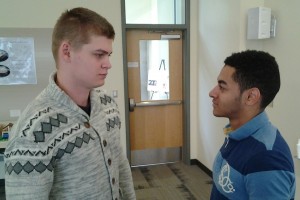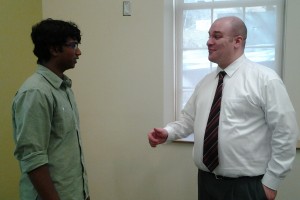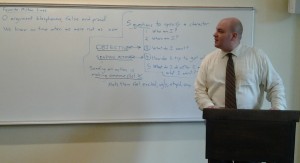I run my first-year composition seminar as an acting class several times per semester. What does that mean? If you were to visit us, here are some of the things you might witness:
- physical and vocal warm-ups
- movement and dance experiments
- improvisation games
- observation exercises
- imagination training
- scene study
- discussion of characters’ motivations and actions
- other performance work
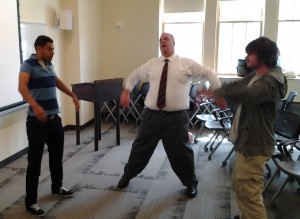
Students including Ethan Telila (L) help me demonstrate how a tension-relieving physical and vocal warmup can free our bodies for more expressive performance. Photo: Josh Ortman.
Below, I’d like to explain to interested TECHStyle readers some of the exercises my students and I do and why we do them. Even if you don’t teach oral/nonverbal communication, or indeed any kind of composition, you may gain something from my post, as I think my methods carry over well into the literature classroom and even into other academic and non-academic contexts.
This post will be on the (quite) long side, as I have three closely related projects: 1) to suggest that a “performance model” for teaching oral and nonverbal communication can serve as a useful corrective to a more conventional “presentation model”; 2) to offer a few examples of our acting exercises and vocabulary and the purposes behind them; and 3) to say how I think this theater work pays off even once students return to their more traditional studies. I considered splitting the post into parts, but in the end I found it more coherent when presented as a united theory and practice. There’s a space at the end of the post for your comments; please do make use of it, as I’m very eager to hear what you think of my methods. I hope you’ll pardon me if at times my tone becomes too manifesto-y. My thinking on these matters is informed by years of talking about theater in a less scholarly way, as I trained practically as an actor in a Stanislavski-derived system (with James DePaul, Bill Walters, James Luse, Michael Tracy, and Alison Chase at Yale) before turning to my academic career. As I say below, though, I’ve found that acting and composition have some vital similarities.
1. Training Voice and Body: Presentation vs. Performance
Students usually enter the university with years of writing classes under their belts. But most of them come to us with very limited training in oral and nonverbal composition: a public speaking course here, a dance class there, a few performances in school plays, or maybe nothing. This state of affairs, combined with our focus (in the Writing and Communication Program here at Georgia Tech) on multimodal WOVEN pedagogy, presents both a problem and an opportunity. The problem: many of our freshmen have never given much thought to how they might use their voices and bodies more effectively. The opportunity: as relative beginners, they have room to get much better at it, very quickly. So I devote several class sessions to acting exercises, asking students to treat their oral and nonverbal communication holistically, as though they were performing a role. I encourage my students to distinguish between this performance model and a more traditional presentation model. The latter can be limiting because it circumscribes a fairly narrow range — the stereotype of the serious, polished, commanding “good speaker” standing behind a podium and microphone — but more crucially because this presentation model tends toward a self-defeating focus on student error.
Presentation, the obsession with error, and the danger of fake work. To gain perspective on the presentation model for oral/nonverbal communication, it’s worth remembering that when teaching writing, expert teachers frequently avoid focusing on surface-level formal elements (such as grammar and mechanics) in isolation, because content (intellectual exploration and creating new knowledge) is more important. Identifying surface errors by covering a student’s paper with red ink is often scorned as unproductive or even harmful to our larger goals. Sometimes it’s better for students to learn conventions more holistically and organically, through more reading and more writing, rather than having skills artificially drilled into them. Most teachers will, I think, recognize the noisome artificiality that can take over when college writers too slavishly attend to form. Students may feign interest, counterfeit understanding, and try to pass off tired formula as original thought. In short, these writers fake their work.
When we teach oral and nonverbal communication with a presentation model, then, I think we risk inviting the same sort of fakery. Using this model, the teacher might assign a format (such as a product pitch or a political speech), observe what her students do wrong when they try it (maybe they’re speaking too softly, they’re not making eye contact, they’re slouching, they’re making statements in a questioning tone, and so on), and instruct them to fix their vocal and physical errors. These well-meaning corrections are akin to all that stern red ink, and the acutely self-conscious presentations that can emerge from such a model are often wooden and lifeless. (I don’t, of course, mean to suggest that all — or even most — presentation-centered instruction falls into this trap; I’m trying only to identify a possible negative aspect of this sort of work.)
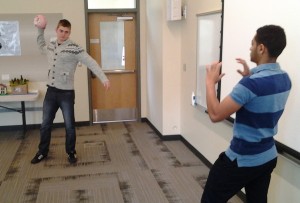
Imagining yourself in a role allows you to act and react naturally, without thinking, letting your subconscious take over. When someone throws a ball at you, you don’t consciously calculate how you’re going to arrange your body to catch or avoid it; you just react in the moment. Once an actor has sufficiently internalized a role, he can speak and move just as naturally. Pictured are students Josh Ortman (L) and Ethan Telila (R). Photo: Jonathan Kotchian.
Performance and truthful work. My teaching of composition and my teaching of acting share a goal: making natural a role and circumstances that at first seem difficult and artificial. A weak essay, a weak speech, or a weak performance might seem empty because its author/speaker/actor is only going through the motions, trying to sound “right” without really making the role his own. By contrast, a strong actor/speaker/author often doesn’t seem to be trying at all; the performance seems natural, as though it were not pretense but real. Actor training in the tradition of the Stanislavski system aims at truthful performances where the actor actually feels, and expresses physically, the emotions of his character, rather than merely indicating them. To achieve this goal, the actor must imagine himself in the character’s shoes, picturing what the character sees, hearing what the character hears; and he must clearly identify the character’s motivation, or objective, to be able to act and react as his character would. When he has successfully imagined and internalized this life, he need no longer laboriously ponder how he ought to walk, how he ought to talk, how he ought to create his facial expressions. These elements of the performance emerge intuitively and organically, just as they do in real life.
Extending this system to non-theatrical contexts is a matter of asking my students to “get into the part” even when they are writing essays or making professional speeches. Sometimes, the roles they play aren’t that different from their own: “academic writer” or “business professional.” Sometimes, to expand their range, I’ll ask them to play sharply different roles; I might tell a tentative or inexact undergraduate essayist to try writing as George Orwell for a while, assign a student reading King Lear to attempt the part of Goneril, or even ask a shy speaker to try being a dragon. (Creativity and expression are easier when you’re not so worried about getting it wrong. If you’re self-consciously trying to conform to the rules of being a good speaker, your performance may become unnatural; but since there aren’t any rules for how to be a dragon, you may naturally find yourself speaking loudly and clearly with a confident command of the space!) Regardless of the role, I ask them to go through the same imaginative steps, getting into the part as naturally as possible. Their composition projects look and sound more lifelike and better-motivated as a result.
2. Acting Exercises and Vocabulary
Below are some of the building blocks necessary to the performance model as I teach it. My students and I need a common vocabulary to discuss how we might take on our various roles, and I teach these concepts by leading some simple exercises, a few of which I’ve outlined below. I’ve gathered this material from my experience with various acting, movement, and voice teachers, and it should give you a good idea of what one of my own classes looks like, or what kind of work I might ask your students to do in a class visit. (I’ve led performance workshops for several fellow teachers’ classes over the last few terms, and would be very happy to do more of them; please get in touch if you’re interested.)
(Attempted) direct connection to another person. On the first day of “acting class,” I tell each student to find a partner and do something that sounds very simple: without speaking, to look into their partner’s eyes, just taking them in, until I tell them to stop. In fact, this turns out to be very hard for most people; exposing yourself so fully to someone else’s gaze usually feels intensely awkward. When queried afterwards, many students report that they “didn’t know what to do” with themselves; they suddenly forgot how to breathe, when to blink, how to stand. They began to hold themselves in unnatural and tense positions. Their attention, far from focused on their partners, was on themselves. We’ve all felt this way at one time or another: arriving alone to a crowded party where we don’t know anyone, for example, we may start to think too hard about how to walk and talk; we might even become so uncomfortable in our own skins that we stutter or trip.
Constantin Stanislavski tells a story in An Actor Prepares that helps us understand the oppressive effects of intense, awkward self-consciousness, and also helps us see how we might move past them. His narrative persona (the novice actor, Kostya) is terrified by the idea of everyone in a large theater watching him:
I went out to the front of the stage and stared into the awful hole beyond the footlights, trying to become accustomed to it, and to free myself from its pull; but the more I tried not to notice the place the more I thought about it. Just then a workman who was going by me dropped a package of nails. I started to help pick them up. As I did this I had the very pleasant sensation of feeling quite at home on the big stage. But the nails were soon picked up, and again I became oppressed by the size of the place. (7)
The trick, as Kostya discovers, is that if you can genuinely focus on something (or someone) else, you’ll forget about yourself. You won’t be thinking about your voice and body anymore, and you can get out of your own way. I usually call that someone/something else a source, to emphasize that an actor can react to it and draw energy from it, in lieu of focusing on herself. A source is usually another person, but it can also be a physical object or even an image, something you picture in your mind’s eye. What to do when you feel self-conscious or paralyzed? Re-invest in your source; attend to those dropped nails, or to your partner, or to your visualized image.
The paired connection exercise above has two purposes: first, to help the students identify that awkward feeling, the better to move past it; and second, to give them a glimpse of how natural (and pleasant) it feels to make a direct connection to a partner, to invest in a source. How do they move from awkward self-consciousness to real connection? Almost inevitably, there comes a moment during the exercise when the students crack up laughing at the silliness and discomfort of the situation I’ve put them in; in that moment, they’re genuinely sharing something, connecting to their partner in the organic way we do when joking with a familiar friend. I ask them to hold on to that moment of truthful interaction, telling them that our goal is to make all their actions and connections just as natural.
Freeing the voice and body: physical exercises. Tension can imprison your voice and body in a tiny jail cell. That’s the most important lesson I teach when I lead physical and vocal warm-ups. Rather than teaching my students to put in more effort to “project” their voices or muscle-up their bodies, I’m instead just trying to get them to relax. (This is particularly beneficial to Tech students, 90% of whom described themselves in 2011 as “very stressed,” compared to a 53% national average for all students.) Gathering my charges into a circle, I usually start with a vigorous shaking-out of the limbs, asking the students to flail about while counting down numbers in sequence (theater readers will recognize the familiar cry of “8-7-6-5-4-3-2-1!”); then, before they have a chance to worry about how they look, we do a “spine-fold”: a standing collapse, bending from the hips, letting the head and arms dangle freely; then we build the spine back up, veerrry slowly, vertebra by vertebra, until the head floats up and the shoulders roll back; then a giant sigh. Almost everyone feels a little better, more awake, more observant, less worried.
I give extra focus to two major trouble spots: the jaw and the belly. Most of us have been taught since childhood to hold these areas in an artificial tension: we hold our mouths closed to avoid tongue-lolling and drooling, and we suck in our guts so as not to look fat. We’re more presentable that way, but these actions clamp down on vital resonating areas. Bouncing and shaking these areas — at first with unvoiced sighs, then with voiced sighs — helps to expand the voice’s range. I explain to students that most people are used to living their whole lives using only a very narrow range of both voice and body, but that they are capable of much more once freed from some of their tension. Rather than replace their narrow range with a “corrected” one that’s just as narrow — a risk taken by the stereotyped presentation model — our goal should be to develop the maximum possible range of their physical instruments. Borrowing from Kristin Linklater’s widely used manual for actors, Freeing the Natural Voice, I speak about this work as “freeing,” to suggest that the larger range exists in potential already and need not be forced. “Try softer,” I tell my students if they become frustrated.
We might then move — gently — to some text: tongue-twisters. I give the students relatively nonsensical ones like “red leather, yellow leather” or “unique New York, unique New York, you know you need unique New York,” and have them wander around the classroom (Hall 102 is good for this purpose, GT readers) while repeating the words to themselves, faster and faster. At first, they don’t look at each other; then, I tell them to demand eye contact from each classmate that passes by, saying the text to him or her. Not only do they limber up their tongues in this way, but they also transition naturally into the next lesson: sending action, or making someone/something feel a certain way.
Sending action. If the action is X, sending or releasing X is making your source feel X. For example, you might make them feel excited, make them feel scared, make them feel weird, or make them feel beautiful. Rather than indicating how she herself is supposedly feeling — trying to contort her face, body, and voice into an imitation of, say, pain — the actor instead invests in her source, trying to make them feel X, where X is “mean” for inflicting the pain, or “powerful” enough to cause the pain, or “merciful” as they come to her aid. Sending “mean” is a way for her to play “I’m in pain!” more organically, with her attention on her source, not herself. Conscious indication is unnecessary; the face, body, and voice will naturally express the emotion without the actor thinking about it. As I tell my students, sending action isn’t something only actors do; we can all think of ourselves as sending actions all the time, as we live our lives. Whenever you’ve made a connection to a source, you’re sending action, even if you’re briskly walking around spouting tongue-twisters. (In that above exercise, students tend to send the actions “silly” or “excited” most of the time, but they’re still sending action.)
We gather in our circle (a formation central to these lessons) again, and try sending action to each other one at a time. Each participant in turn chooses a source across the circle, and sends them action X (I start them off with easy ones, like “ugly” or “amazing”) while saying some nonsense text. To keep their attention off how they look and sound, I have them throw an inflatable ball around the circle as they send each action. They know how to throw a ball, just as Kostya knows how to pick up nails. I ask them to increase their actions’ specificity and urgency by using Stanislavski’s magic if. I suggest that they imagine something extreme: how would they send the action “scared” … if they had only seconds to save their source’s life by frightening them away from an electrified fence? We close this work with another partner exercise designed to open up the students to truthful emotional connection. I tell them to try speaking the text “I could really be hurt by you” while sending chosen actions such as “loved” or “hated.” After a while, they gain confidence in identifying the actions sent by others, and in responding to them naturally.
Objectives and scene study. I give my students five questions to ask themselves when creating a role, whether the role is Goneril or “hotshot businessman”:
- Who am I?
- Where am I?
- What do I want?
- How do I go about getting what I want?
- What do I do after I do/don’t get what I want?
The third question is the most important because it asks them to define their objective, or motivation. The objective, in turn, will lead them to choose certain actions (the answers to question #4). For example, as Goneril, I might want Lear to get out of my house; this would be my objective. As my scene progressed and my circumstances (developed through questions #1 and #2) changed, I would try different actions to achieve the objective. I might send to Lear the action “powerful,” then “presumptuous,” then “stupid,” then “frightened,” and finally “annihilated,” matching these with my spoken lines. When working with a dramatic scene, I ask my students to identify only one objective per scene, but choose several actions that might help them get what they want; this helps to create a natural variety in performance. We examine how different performance choices might lead to different literary interpretations, as well.
We can treat as a role even something less obviously theatrical, like a business presentation, and prepare the role by answering the questions above. If I don’t feel confident/authoritative enough in making my sales pitch, for example, I might place myself into the role of Captain Picard (minus the accent), or I might instead imagine a businessman, “Joey Pitcheroo,” much more experienced and slicker than myself. I would then choose the objective and actions that Joey might use to make his sale. This technique might help me discover a counter-intuitive, but effective, action. I might decide to make my audience feel “hardly cool enough to buy my product!” and moreover imagine them as overeager schoolchildren instead of corporate executives. Exercises like these allow students to range far beyond presentation personae that are only un-slouchy versions of themselves. Asking students to imagine thirty of their character’s likes and dislikes is one way to ensure specificity in preparing a role; it’s essential not to skimp on the imaginative work, as it’s what creates the broad range of possibilities for performance.
Movement and the tableau. The performance techniques above apply to movement as well as to speech and emotion. The core idea is to let the movement emerge naturally by imagining oneself in the role, rather than starting with a conscious plan of how to walk. I’ll focus here on just one quick movement exercise I use to expand the students’ physical range: the tableau. While the rest of the class watches from one side, I instruct a small group of volunteers to stand in the center of the room, which I’ve littered with random objects to use as makeshift props. I then give them some entity they’re to represent (“War!” “God’s love in Paradise Lost!” “The Fool’s heart!” “A jet engine!”), counting down quickly from ten. When I get to zero, they’re to freeze, motionless, in a tableau. The key to avoiding self-consciousness (and freeing the subconscious to invent interesting movements and poses) is not letting them think too much. My most common exhortation is “Don’t think; move.”
Not only is the tableau itself an interesting artifact that can be revised and remixed in further group performance, but the movement students undertake to strike the tableau often leads them to carry themselves physically in new ways: scrambling when they usually stride, taking up more or less space than usual, or making contact with their fellow improvisers in nonstandard ways. Again, the surreal nature of the exercise can be liberating. Society’s usual rules for position, motion, and touch don’t apply here. I advise students to observe small children’s movement for this very reason; kids haven’t yet internalized those rules, so they move very naturally, reacting with their whole bodies, oblivious to how silly they might look. Such work enables the students to return to their less surreal roles with far more possibilities for performing movement.
3. Lasting Effects of Theater Training
Inventing the university, inventing the role. When we use the above techniques to perform a role, are we really acting genuinely and truthfully? After all, the role is still a role; doesn’t that suggest at least some artificiality? Perhaps, but consider that metaphor we sometimes use for the work of an actor expertly playing a part: we say that he has “made the role his own.” Those words suggest that it’s possible for a role to become, in a way, part of the performer. Consider the role of “academic writer,” one familiar to most of my readers. Most professional scholars have successfully made this role their own. I think of my “academic writer” persona as an aspect of myself, because I actually think and feel the things I write, even if I write them in a style different from the one I use in ordinary conversation. Yes, I frequently alter my writing to fit various circumstances, but I wouldn’t say I’m being fake. It’s second nature now. I’m being genuine in a different way, one I’ve had to figure out as I go along.
Our students, likely much more than we, are figuring their roles out as they go along, and I think my performance methods help them do it more truthfully. In his influential essay “Inventing the University,” David Bartholomae shows how beginning college students struggle to imagine their roles in the unfamiliar context of the academy. They must learn “to speak as we do, trying on the peculiar ways of knowing, selecting, evaluating, reporting, concluding, and arguing that define the discourse of our community” (4). But this is not easy, as to do it they must “invent the university by mimicking its language, finding some compromise between idiosyncrasy, a personal history, and convention, the history of a discipline. They must learn to speak our language. Or they must dare to speak it, or to carry off the bluff, since speaking and writing will most certainly be required long before the skill is ‘learned'” (5). In my view, students frequently fall back on fake and unnatural work because they think it’s their best option. They feel the pressure to “carry off the bluff” somehow, and warmed-over formula is their best guess at what the teacher wants to hear or read. I try to convince them that they can instead “carry off the bluff” in ways that make it less of a bluff, less wooden and lifeless. I teach them how they might treat each role not merely as a set of conventions to be obeyed or feigned, but also as something personal, idiosyncratic, something to be made their own. A more genuine performance, a more genuine invention of self and university, is much more likely to lead to real intellectual and personal change.
I’ve been understating, of course, the time I spend on convention and student error. Some student projects must eventually develop toward suitability for professional contexts, and my performance methods do not always lead them organically to optimal solutions. Sometimes I do need to step in and offer more formal guidance. But it is vital, I think, that students see convention as relatively unimportant, as the mere smoothing-out of some rough spots, as a natural obstacle that they can negotiate as part of their chosen role. Once students understand that it’s a valid part of their job to figure out the gritty details of how to get into the part — how to stop faking it, how to perform more naturally their thinking, reading, writing, speaking, and moving — they often feel liberated. Attending to their own processes of self-transformation, rather than attempting to conceal, rush, or deny them, takes away the burden of pretense, as they no longer feel compelled to construct a false front to please their teacher. Rather, they can reflect on how they wish to fit into their new roles, how to inhabit them organically, and how to use them as the means to explore projects of their own. Their lives as students, as professionals, and as humans may be more fully and truthfully lived as a result.
Composition, literature, and beyond. It’s easiest to see the benefits of the performance model in the context of oral and nonverbal communication. A student actor’s speech and movement are likely to improve as she expands her vocal and physical range, positions herself in a chosen role, and completes her imaginative work on the role’s circumstances, objectives, and actions. When this student work is well-motivated, even if it strays too far from the bounds of convention, it is easier to judiciously draw it back than it is to begin with an artificial formula and try to stuff invention into it. Too, I’ve outlined above how I think performance works in synergy with writing, and by extension other modes of composition. An essay writer can more easily find his own voice and ideas when he sees “inventing the university” as a good-faith role instead of an artificial requirement, and student composers in the visual or electronic modes may likewise come to treat their work as truthful, rather than fake, participation in an academic or professional conversation.
I’ve found that actor training’s emphasis on roles can be invaluable in the study of literature, as well. Asking a student to imagine herself in conversation with an author may lead her to take a more nuanced position on a text. Study of a character as a performable role can develop much more room for interpretation. The performance approach is especially useful when I teach early modern literature, where historical distance can make it harder for students to imagine how their own lives might intersect with the texts and contexts studied. When I teach Shakespeare’s As You Like It and ask my students to re-read its commentary on nature and culture through the lens of Stanislavski’s theories, they become much better able to propose and evaluate differences between natural and artificial behavior, because they can ground their analyses in their own experiences with authenticity and fakery. Paying attention to their own roles often persuades students of the value of attending closely to the (sometimes quite different) roles of early English authors, actors, and audiences.
Indeed, if one lasting benefit of literature is that it helps us to think differently, to take on a perspective foreign to us, then acting training is especially valuable in literary study, as it makes the process of seeing through another’s eyes more natural. Empathy, that peculiar quality that makes it possible for humans to live with one another, depends on this ability to endlessly perspectivize, to imagine the other not only as a stranger but also, somehow, ourselves. The skill of understanding others’ thoughts and emotions is developed most aptly by learning to take on roles. This skill, I think, will serve my students well whenever they forge vital connections, wrestle with difficult meaning, imagine new possibilities, or create new knowledge, in or out of the academy.
In conclusion
Please do get in touch if you have any thoughts at all about the above methods, especially if you see connections between this post and your research and/or teaching interests, and especially if you’d like to invite me to visit your class (or if you’d just like to visit mine). My contact information is at the end of this post, or you can use the handy comments feature below. I’ll be keeping a close eye on that space.
The post is more than long enough already, but I’d like to leave you with another passage from Stanislavski. I use the story below (from his autobiographical My Life In Art) to explain to my students the difference between fake work and truthful work — not only in the theater, but in composition, literature, and beyond.
This took place on our estate, about thirty versts from Moscow, in one of the wings of our house. A small children’s stage was erected there, with a plaid cloth instead of a curtain. As custom has it, the entertainment was composed of tableaux, in this case the four seasons of the year. I was about two or three years old at that time, and impersonated Winter. The stage was covered with cotton; in the centre there was a small evergreen, also covered with cotton, and on the floor, wrapped in a fur coat, with a fur hat on my head, and a long beard that would insist on crawling up my forehead, sat I, without knowing where to look and what to do. This impression of aimlessness, bashfulness and the absurdity of my presence on the stage, was felt by me subconsciously at that time, and even now it is alive in me and frightens me when I am on the stage. After the applause, which I remember was very much to my liking, I was placed on the stage again, but in a different pose. A candle was lit and placed in a small bundle of branches to make the effect of a fire, and I was given a small piece of wood which I was to make believe I put into the fire.
“Remember, it is only make-believe. It is not in earnest,” the others explained to me.
And I was strictly forbidden to bring the piece of wood close to the candlelight. All this seemed nonsensical to me. Why should I only make believe when I could really put the wood into the fire? And perhaps that was what I had to do, just because I was forbidden to do it?
In a word, as soon as the curtain rose, I put out the hand with the piece of wood towards the fire with great interest and curiosity. It was easy and pleasant to do this, for there was meaning in the motion; it was a completely natural and logical action. Even more natural and logical was the fact that the cotton caught fire. There was a great deal of excitement and noise. I was unceremoniously lifted from the stage and carried into the big house, where I was severely scolded. In short I had failed cruelly, and the failure was not to my taste. These four impressions, of the pleasure of success, of the bitterness of failure, of the discomfort of unreasonable presence on the stage, and the inner truth of reasoned presence and action on it, control me on the stage even at the present day. (23-24)
Works Cited
Bartholomae, David. “Inventing the University.” Journal of Basic Writing 5:1 (1986). 4-23.
Linklater, Kristin. Freeing the Natural Voice. Hollywood: Drama Publishers, 2006.
Stanislavski, Constantin. An Actor Prepares. Trans. Elizabeth Reynolds Hapgood. New York: Routledge, 1989.
—. My Life in Art. Trans J. J. Robbins. Cleveland: Meridian, 1963.
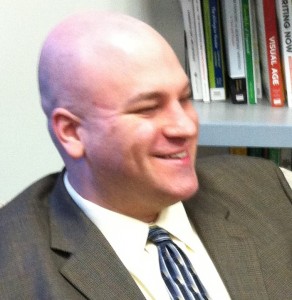
Jonathan Kotchian. Photo: Kim Armstrong.
About the author: A Brittain Fellow since 2012, Jonathan Kotchian (PhD and MA in English, University of Connecticut; BA in theater, Yale University) is revising his first book project, which shows how the figure of the superior author in early modern England co-evolved with satire. His second book project, which continues his investigation of “insider” literature accessible only to certain readers or viewers, explores the relationship between concepts of intelligence and literary taste. His interests range from Shakespeare and Milton to using theatrical training techniques in the multimodal composition classroom, where he asks his students to foreground their own motivations, self-presentations, and affective responses. Key interests: early modern literature, composition, authorship, satire, intelligence, drama, theater, interactive fiction games, and digital humanities. He can be reached by e-mail at jonathan.kotchian@lmc.gatech.edu or jkotchian@yahoo.com, and via Twitter @JonKotchian.

